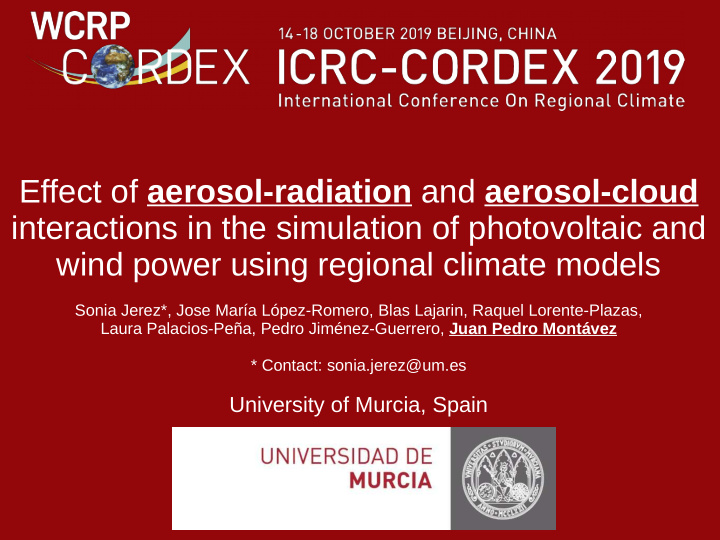



Effect of aerosol-radiation and aerosol-cloud interactions in the simulation of photovoltaic and wind power using regional climate models Sonia Jerez*, Jose María López-Romero, Blas Lajarin, Raquel Lorente-Plazas, Laura Palacios-Peña, Pedro Jiménez-Guerrero, Juan Pedro Montávez * Contact: sonia.jerez@um.es University of Murcia, Spain
MOTIVATION: previous works ● Increasing use of RCM to evaluate the renewable resource (wind, solar), with previous works indicating a key role of aerosols for such applications. Differences in PV yearly productivity (in %), averaged by country, for the period 2003–2009 between RCM simulations with and without ARI effects. ►Gutiérrez et al. (2018). Impact of aerosols on the spatiotemporal variability of photovoltaic energy production in the Euro-Mediterranean area. Solar Energy, 174, 1142-1152. ● Discrepancies between GCM and RCM future projections for the solar resource. ►Jerez et al. (2015). The impact of climate change on photovoltaic power generation in Europe. Nature Communications, 6, 10014. ►Bartók et al. (2017). Projected changes in surface solar radiation in CMIP5 global climate models and in EURO-CORDEX regional climate models for Europe. Climate Dynamics, 49(7-8), 2665-2683. 2
MOTIVATION: ARI vs. ACI and their scarcely studied effect in RCM long-term experiments Aerosol-cloud interactions (ACI) Aerosol-radiation interactions (ARI) 3 Source: https://allaboutaerosol.com
EXPERIMENTS WRF-Chem was used to downscale ERA20C and the CMIP5 MPI-ESM-LR _r1i1p1 historical and RCP8.5 runs (performed with the global model ECHAM6) for the periods 1991-2010 and 2031-2050 over an Euro-Cordex compliant domain with 0.44º resolution. 50 N 50 N Three sets of simulations were performed: 4 N constant aerosol concentrations 0 0 N 4 BASE without interactions 30 N 30 N variable (online diagnosed) aerosol concentrations, under ARI 20 N 20 N constant emissions, with aerosol-radiation interactions m 10 N N 0 0 500 1000 1500 2000 2500 1 variable (online diagnosed) T errain Height aerosol concentrations, under ACI 1 30 E 0 20 E 0 10 E W constant emissions, with Domain 1 (1.32º) → S aharan dust aerosol-cloud interactions Domain 2 (0.44º) → Euro-Cordex 4
RESULTS: RSDS climatology (JJA 1991-2010) * RSDS stands for Surface Downward Solar Radiation 5
RESULTS: RSDS climatology (JJA 1991-2010) * RSDS stands for Surface Downward Solar Radiation 6
RESULTS: RSDS climatology (JJA 1991-2010) 7
RESULTS: RSDS climatology (JJA 1991-2010) 8
RESULTS: RSDS climatology (JJA 1991-2010) 9
RESULTS: RSDS climatology (JJA 1991-2010) 10
RESULTS: RSDS climatology (JJA 1991-2010) ACI vs. ARI: matching the different aerosol effects on radiation, cloud cover and aerosol optical depth (a) RSDS ACI-ARI (JJA) (b) CLT ACI-ARI (JJA) (c) AOD ACI-ARI (JJA) 11
RESULTS: RSDS change (JJA 2031-2050 vs. 1991-2010) RSDS CLT AOD 12
RESULTS: Implications for Solar Power Solar power productivity change (JJA 2031-2050 vs. 1991-2010) 13
RESULTS: Implications for Wind Power Wind power productivity change (DJF 2031-2050 vs. 1991-2010) 14
CONCLUSIONS In present-day simulations, aerosols interactions reduce the amount of solar radiation reaching the surface , both ARI and ACI. The reduction is smaller when ACI are included in the RCM execution, because we got less cloud coverage and less AOD as compared to the ARI experiment, so ACI partly counteracts the ARI effects . In terms of future changes, BASE and ARI projections are the most similar between them, with the ARI patterns being the most similar to the patterns retrived from the driving global simulation. So ARI certainly reduce the discrepancy between GCM and RCM projections . Again, the inclusion of ACI counteracts the ARI effects , not only in the projections for the solar resource, but also for the solar and wind power productivity. As much as that ARI and ACI projections provide change signals of different sign in some cases. 15
Thank you for your attention! Effect of aerosol-radiation and aerosol-cloud interactions in the simulation of photovoltaic and wind power using regional climate models Sonia Jerez*, Jose María López-Romero, Blas Lajarin, Raquel Lorente-Plazas, Laura Palacios-Peña, Pedro Jiménez-Guerrero, Juan Pedro Montávez * Contact: sonia.jerez@um.es University of Murcia, Spain
Recommend
More recommend